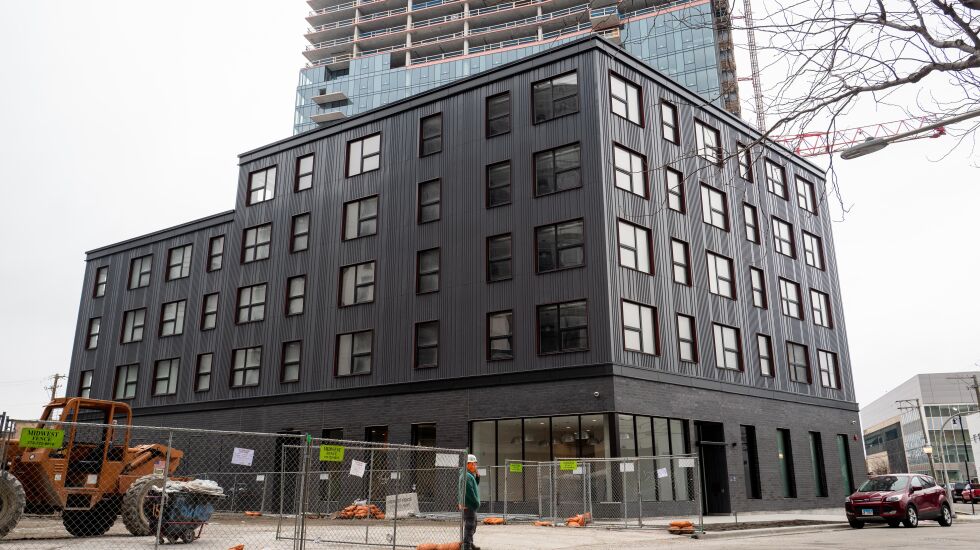
As a founding principal of the firm Structured Development, J. Michael Drew is an unabashed capitalist, a label not popular in some quarters. But he looks for answers to the problem of affordability in city living.
New construction housing in the core of Chicago is a market that works fabulously well for high-end buyers. Mandated city set-asides of “affordable” units add options for those with lower incomes. What about two-income couples with children and steady jobs who don’t pay vast sums? Home ownership can still be a stretch, and they don’t qualify for most subsidized units.
Drew called it “the missing middle” of today’s demand. So on Near North Side property where his firm has been investing for around 20 years, he has opened a new residential building called The Seng at 869 W. Blackhawk St., a short distance from the traffic-clogged retail arteries of North and Clybourn avenues.
It’s worth noting The Seng — more on the name later — is a condo building, not apartments. Rentals are the preferred option for developers in search of high-salaried rent-payers who don’t want to give a down payment.
It also is Chicago’s largest 100% affordable condo building and, with only two-, three- and four-bedroom units, it is designed for families. The project is partial fulfillment of Drew’s obligation to build affordable units as part of Structured’s broader development plans.
Drew said the buyers can build equity in an attractive neighborhood where condo units typically trade for prices higher than what he’s charging. Working with a city agency, the Chicago Housing Trust, Drew is pricing the units to be affordable for buyers earning up to 120% of the area’s median income. Under federal rules, qualified buyers can have an income no greater than $100,080 for a two-person household or $125,040 for a family of four.
Prices start at $285,000 for the two-bedrooms and go up to $374,696 for four-bedroom units.
So while it’s not housing for the poor, it can be considered workforce housing, an entry-level home in a hot area. Drew’s marketing materials call it Lincoln Park, which most will say is off the mark because his property is south of North Avenue, but Near North Side has cachet, too.
Drew said the workforce element adds housing variety to the neighborhood. “The pricing is such that it will be a very attractive investment,” Drew said. There are deed restrictions that prevent buyers from reselling for a quick profit.
Prospective buyers need to go through the Chicago Housing Trust, which works with lenders to help people afford a home and to promote equity in neighborhoods where gentrification dominates.
Applications for The Seng have been open since Feb. 27. Structured reported more than 50 have been submitted, and it has conducted more than 100 tours of the property.
The Chicago Housing Trust said it will hold a lottery for the two-bedroom units on March 16 because they’ve proven the most popular.

The Seng is a five-story building by GREC Architects that has a couple of new-construction neighbors hot on its heels on land along Blackhawk, Dayton and Kingsbury streets.
By late April, Drew plans to open Post Chicago, a 10-story, 432-bed co-living development, marketed to those who want to rent a bedroom and share a kitchen and furnished living room with others, almost like an extension of dorm life. “You bring a suitcase and you can move right in,” Drew said. Its architecture is by Chicago-based Built Form.
The bedrooms will go for about $1,600 per month. Drew said his typical customers will be in their late 20s and make a decent salary, perhaps as a corporate transfer who doesn’t expect a permanent assignment in Chicago. The leases will run about six to 10 months, he said.
The final building in the mix will be a traditional market-rate apartment tower called the Foundry, a 27-story, 327-unit building due at the end of 2023. Its design is by FitzGerald Associates.
The three buildings will be grouped around a more than half-acre open space that’s supposed to include a dog run — an all-important amenity these days — and a community garden.
The Seng’s name pays tribute to the former Seng Co., which had a vast factory on the property in the early 20th century. It was a leading manufacturer of furniture hardware and an early producer of sofa-sleepers and recliner chairs. A long ago ad for its Seng Spring Turkish Rocker told its audience, “Get this luxurious chair for grandfather.”
Drew’s firm has tracked down art and artifacts related to the company, including items recovered from a 1902 time capsule the construction crews unearthed. Some items will go on display in the building’s lobby. The firm’s founder was a German immigrant, Wendelin Seng, so Drew is calling the open space Wendelin Park.








